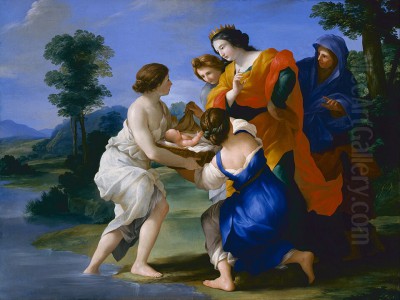
Giovanni Francesco Romanelli (1610–1662) stands as a significant figure in the landscape of seventeenth-century Italian painting. Born in Viterbo, near Rome, his career unfolded primarily in the papal city and, crucially, in Paris, making him an important conduit for the transmission and adaptation of Baroque artistic ideas between Italy and France. Trained in the vibrant artistic milieu of Rome during the ascendancy of the High Baroque, Romanelli developed a style characterized by its elegance, rich colour, and narrative clarity, distinguishing himself amidst a generation of remarkable talents. His association with powerful patrons, most notably the Barberini family in Rome and Cardinal Mazarin in Paris, propelled his career, securing him prestigious commissions that included large-scale fresco decorations and easel paintings. While deeply rooted in the Roman tradition, his experiences in France added a distinct dimension to his work, contributing to the complex tapestry of European Baroque art.
Early Life and Artistic Formation in Rome
Giovanni Francesco Romanelli's artistic journey began when he moved to Rome as a young teenager, around the age of 14. The city, then the undisputed centre of the European art world, was brimming with creative energy, largely fueled by the patronage of the Church and powerful aristocratic families. The dominant artistic force was the burgeoning Baroque style, characterized by drama, dynamism, and emotional intensity. It was in this stimulating environment that Romanelli sought training, eventually entering the studio of Pietro da Cortona (1596–1669), one of the most influential and innovative painters of the Roman High Baroque.
Cortona's studio was a crucible of talent, known for its large-scale decorative projects, particularly the monumental ceiling fresco in the Gran Salone of the Palazzo Barberini. Working under Cortona exposed Romanelli to the principles of grand manner decoration, complex allegorical programmes, and a fluid, painterly technique. He absorbed Cortona's emphasis on movement, rich colour harmonies, and the integration of painting, sculpture, and architecture – hallmarks of the High Baroque aesthetic pioneered by artists like Gian Lorenzo Bernini (1598–1680) and Francesco Borromini (1599–1667) in their respective fields.
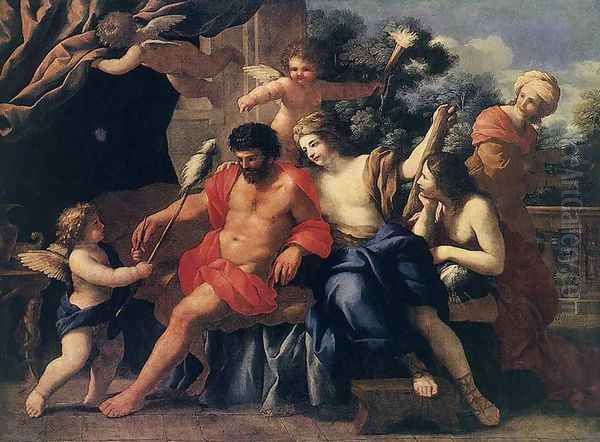
Romanelli quickly proved himself a capable student, mastering the fundamentals of drawing and painting. His early works inevitably show the strong influence of his master, yet hints of a distinct artistic personality began to emerge. He demonstrated a preference for clearer compositions and a slightly more restrained emotional tenor compared to Cortona's exuberant dynamism. This inclination perhaps aligned him subtly with the more classicizing currents within Roman Baroque, represented by artists such as Andrea Sacchi (1599–1661) and the Bolognese painters like Domenichino (1581–1641) and Guido Reni (1575–1642), who emphasized order, grace, and idealized forms derived from Raphael and classical antiquity.
The Barberini Patronage and Emerging Independence
Romanelli's talent did not go unnoticed. He came under the protection of the powerful Barberini family, particularly Cardinal Francesco Barberini, nephew of Pope Urban VIII. This patronage was crucial for a young artist seeking to establish himself in Rome's competitive art scene. Employment within the Barberini household provided Romanelli with financial stability and access to prestigious commissions. He likely contributed to decorations within the Palazzo Barberini, working alongside his master Cortona and other artists employed by the family.
However, Romanelli's relationship with Pietro da Cortona eventually soured. Accounts suggest a significant dispute arose between master and pupil, the exact nature of which remains unclear but was serious enough to cause a definitive break. This rupture forced Romanelli to leave Cortona's studio and forge his own independent career path. While potentially challenging, this separation may have also been artistically liberating, allowing Romanelli to develop his personal style more freely, moving further from Cortona's direct influence.
Despite the break with Cortona, Romanelli retained favour, at least for a time, within certain circles. His skills were recognized, and in 1639, he achieved a significant milestone: election as Principe (Prince or Head) of the prestigious Accademia di San Luca. This position, leading Rome's official artists' guild and academy, was a mark of high esteem from his peers and solidified his status as a respected master in the city. It demonstrated his ability to navigate the complex social and professional networks of the Roman art world, even after parting ways with his influential teacher.
Artistic Style: Elegance, Colour, and Clarity
Giovanni Francesco Romanelli's mature style is often described as a refined and elegant interpretation of the Baroque. While he embraced the movement and richness characteristic of the era, his work generally possesses a greater sense of order and clarity than that of his former master, Pietro da Cortona. His compositions are carefully structured, often built upon stable diagonals or pyramidal arrangements, guiding the viewer's eye through the narrative with ease.
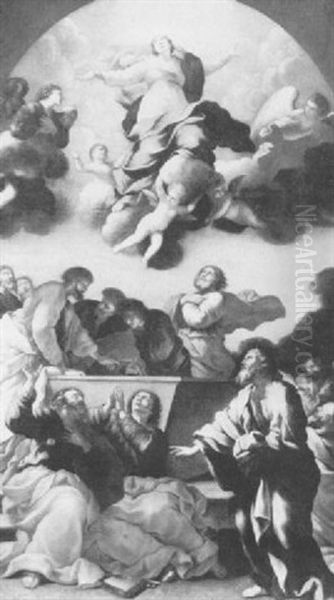
Colour was a key element of Romanelli's art. He employed a vibrant palette, favouring rich reds, deep blues, golds, and luminous whites. His colours are applied with a noticeable clarity and brilliance, contributing to the decorative appeal of his works. Unlike the more blended, atmospheric effects sought by some contemporaries, Romanelli often defined forms with clear outlines and distinct local colour, enhancing the legibility of his scenes. This clarity extended to the rendering of details – fabrics, armour, architectural elements – which he depicted with meticulous care.
His figures typically display a graceful elegance, often inspired by the ideals of Raphael and the classicizing tradition of the Bolognese school, particularly artists like Guido Reni and Domenichino. Female figures, in particular, often possess a gentle, idealized beauty, sometimes described as "Raphael-esque," which became a hallmark of his work, especially in the 1650s. While capable of conveying emotion, his figures generally maintain a sense of decorum and restraint, avoiding the extreme emotionalism found in the work of more dramatic Baroque painters like Caravaggio (1571–1610) or even Bernini in sculpture. His approach balanced Baroque dynamism with classical grace.
Major Works in Rome
During his Roman periods, Romanelli undertook several important commissions, although the waning influence of the Barberini family after the death of Pope Urban VIII in 1644 somewhat impacted his local patronage base. Nevertheless, he contributed works to significant locations. His paintings could be found in Roman churches and palaces, demonstrating his versatility in handling both religious and mythological subjects.
Among his notable works often cited from this period are paintings like the Presentation in the Temple, which showcases his ability to handle multi-figure compositions with clarity and devotional feeling. Another significant work is the Deposition from the Cross, a theme demanding emotional weight, which Romanelli approached with characteristic sensitivity and compositional balance. These religious paintings demonstrate his engagement with Counter-Reformation ideals, presenting sacred narratives in an accessible yet dignified manner.
His mythological paintings, such as Hercules and Omphale, allowed him to explore themes of love, power, and transformation, often featuring his signature elegant figures and rich settings. His work for the Vatican Museums further attests to his standing. While specific details of all his Roman commissions require careful reconstruction, his presence in major collections like the Vatican confirms his role within the mainstream of Roman art production during the mid-seventeenth century. He successfully navigated the stylistic currents, blending Cortona's High Baroque energy with a more classical sensibility.
The Call to Paris: Cardinal Mazarin and Royal Commissions
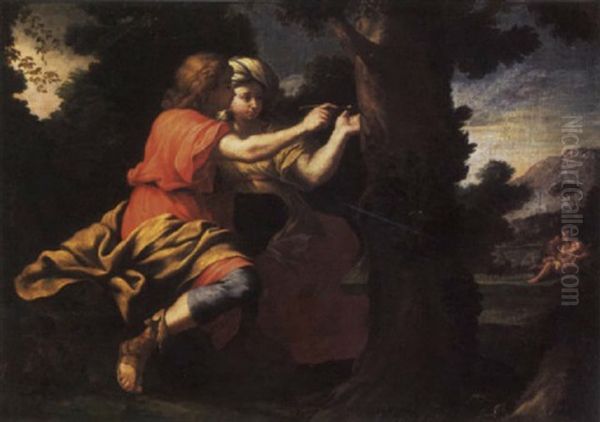
A pivotal turn in Romanelli's career came with the invitation to travel to Paris, extended by the powerful Cardinal Jules Mazarin (1602–1661). Mazarin, the Italian-born chief minister of France during the regency of Anne of Austria and the minority of Louis XIV, was an avid art collector and patron, keen on bringing Italian artistic prestige to the French court. He had previously employed Roman artists and saw in Romanelli a painter capable of executing grand decorative schemes in the latest Roman style.
Romanelli first travelled to Paris around 1646-1647. His primary task was to decorate parts of Mazarin's newly renovated Parisian residence, the Palais Mazarin (now part of the Bibliothèque Nationale de France). Here, he painted a series of frescoes based on themes from Ovid's Metamorphoses, showcasing his narrative skill and elegant style. These works were highly praised and significantly enhanced Romanelli's reputation in France.
His success with Mazarin led to even more prestigious commissions. Anne of Austria, the Queen Mother, employed him to decorate her summer apartments in the Louvre Palace. This was a major undertaking, involving complex allegorical programmes celebrating the Queen and the French monarchy. Romanelli's frescoes in the Louvre, with their bright colours, clear compositions, and graceful figures, were well-suited to the tastes of the French court, which appreciated clarity and elegance alongside grandeur. His work provided a fashionable Italian alternative to the established French painters like Simon Vouet (1590–1649), who had himself spent years in Italy.
Return to Italy and Shifting Fortunes
After his successful first period in Paris, Romanelli returned to Viterbo and Rome around 1648. The political and artistic landscape in Rome had shifted. The death of Pope Urban VIII had led to the temporary disgrace of the Barberini family and the rise of the Pamphilj family under Pope Innocent X. While Romanelli still found work, the loss of his primary patrons likely affected the scale and frequency of major commissions available to him in Rome.
Despite these changes, he remained active. He continued to produce easel paintings for various clients and potentially contributed to ongoing decorative projects. His style continued to evolve, perhaps absorbing further classical influences or responding to the works of contemporaries like Nicolas Poussin (1594–1665) and Claude Lorrain (1600–1682), French artists who spent most of their careers in Rome and championed a more severely classical landscape and history painting.
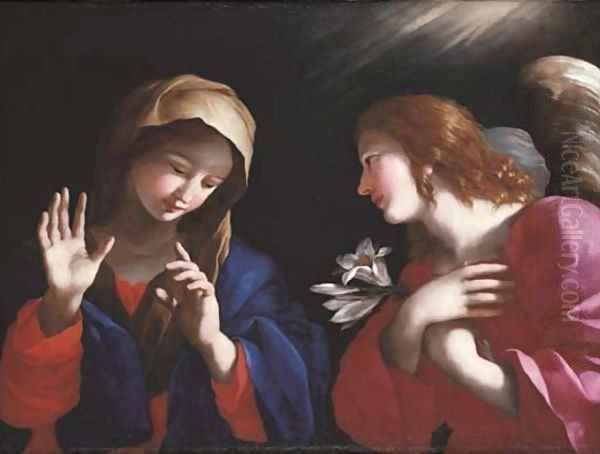
However, the allure of French patronage remained strong. The success of his earlier work in Paris had established his reputation there, and the opportunities offered by the French court, particularly under the consolidating power of the young Louis XIV and the continued influence of Mazarin, were significant. This set the stage for a second, extended period of activity in France.
Second Parisian Period and Last Years
Romanelli returned to Paris in the mid-1650s (around 1655-1657) and remained there for several years. This second stay cemented his role as a key figure in the decoration of the royal palaces. He continued his work in the Louvre, contributing further frescoes to the royal apartments. His paintings, often depicting scenes from history, mythology, and allegory, helped to shape the visual environment of the emerging absolutist monarchy under Louis XIV.
His style during this period maintained its characteristic elegance and clarity, but perhaps gained an even greater decorative richness, responding to the luxurious tastes of the French court. His work was highly regarded, and as a sign of royal favour, he was made a knight of the Order of Saint Michael by Louis XIV. This honour underscored his success and acceptance within the highest echelons of French society.
His presence in Paris placed him in direct dialogue, and sometimes competition, with the rising generation of French artists who were forging the distinctive style of French classicism under the emerging dominance of Charles Le Brun (1619–1690). Romanelli's Italian Baroque, with its slightly softer, more painterly qualities, offered a contrast to the more linear and academically rigorous approach favoured by Le Brun and his followers like Eustache Le Sueur (1616–1655). Romanelli's influence can be seen in the decorative arts of the period, bridging the gap between Italian Baroque and the developing Grand Siècle style in France. He returned to Viterbo shortly before his death in 1662, leaving a significant body of work in both Italy and France.
Tapestry Design and Decorative Arts
Beyond fresco and easel painting, Romanelli was also involved in tapestry design, a highly prestigious and costly art form in the seventeenth century. He created cartoons (full-scale preparatory designs) for the Barberini tapestry manufactory in Rome, one of the most important workshops of its kind. These designs, often depicting historical or mythological scenes, required a clear narrative structure and decorative sensibility suitable for translation into woven form.
One notable example is the series depicting the life of Constantine, commissioned by Cardinal Francesco Barberini. Romanelli's designs for tapestries like Venus telling Aeneas and Achates to go to Carthage (a design now associated with the Cleveland Museum of Art) demonstrate his ability to adapt his compositional skills to the specific demands of the medium. Tapestry required bold forms, rich colours, and intricate borders, elements that Romanelli handled with aplomb. His involvement in tapestry design highlights the versatility expected of leading artists in the Baroque era, who often worked across multiple media.
Technique and Workshop Practice
Romanelli was proficient in both major painting techniques of his time: fresco and oil on canvas. For his large-scale decorative cycles in Rome and Paris, he primarily used fresco, likely the buon fresco technique where pigments are applied to wet plaster, creating a durable and luminous surface integral to the wall itself. This demanding technique required careful planning and rapid execution, often involving numerous assistants working under the master's direction.
His workshop likely included apprentices and assistants who helped with preparing surfaces, transferring cartoons, grinding pigments, and painting less critical areas. His son, Urbano Romanelli (1645–1682), followed in his footsteps as a painter, likely training and working within his father's studio. Another documented pupil was Giovanni Moneri (or Monevi) from Visso. The collaborative nature of large fresco projects was standard practice, allowing masters like Romanelli to undertake extensive commissions efficiently.
For easel paintings, Romanelli worked in oil on canvas. This medium allowed for greater detail, richer colour saturation, and the possibility of revisions. His oil paintings showcase his refined brushwork and careful attention to texture and light, creating works suitable for private devotion or collection by connoisseurs. Preparatory drawings, often in chalk or ink and wash, would have been crucial for developing compositions for both frescoes and oil paintings.
Influence and Legacy
Giovanni Francesco Romanelli occupies an important, if sometimes overlooked, place in Baroque art history. His primary significance lies in his role as a transmitter of Roman Baroque decorative styles to France. His work for Mazarin and the French Crown provided a direct infusion of Italian artistic ideas, influencing French taste and decorative painting before the full consolidation of Charles Le Brun's academic classicism.
While perhaps not as revolutionary as his teacher Pietro da Cortona or as influential in the long term as contemporaries like Poussin or Bernini, Romanelli carved out a distinct niche. His elegant, colourful, and compositionally clear style offered an appealing synthesis of Baroque dynamism and classical grace. It represented a slightly more restrained and accessible version of the High Baroque, which found favour with patrons in both Rome and Paris.
His students, particularly his son Urbano, continued his stylistic lineage, primarily in central Italy. His works remain in major collections, including the Louvre, the Vatican Museums, and various galleries across Europe and North America, bearing witness to his skill and the international reach of his career. He stands as a testament to the fluidity of artistic exchange in seventeenth-century Europe and the enduring appeal of the Italian Baroque tradition.
Contemporaries and Artistic Context
Romanelli's career unfolded during a period of extraordinary artistic ferment. In Rome, he worked alongside or in competition with giants like Bernini, Borromini, Cortona, and Sacchi. He witnessed the presence of influential foreign artists like Poussin and Claude Lorrain, whose classical ideals offered a counterpoint to the High Baroque. He also contended with the legacy and followers of the Carracci school, including Domenichino, Reni, and Guercino (1591–1666), whose Bolognese classicism remained a powerful force. The anecdote of him accusing Domenichino of plagiarizing Annibale Carracci (1560–1609), whether accurate or apocryphal, highlights the competitive atmosphere and the debates around originality and influence.
In Paris, he encountered the established French master Simon Vouet, who had brought his own interpretation of the Italian Baroque back to France years earlier. More significantly, Romanelli's later work coincided with the rise of Charles Le Brun, who would soon dominate French art under Louis XIV, establishing a more formal, state-controlled academic style. Romanelli's Italianate elegance provided a different flavour, contributing to the diverse artistic landscape of mid-century Paris before the full imposition of the "Louis XIV style." His patrons, Cardinal Mazarin and Anne of Austria, were central figures in the political and cultural life of the era, using art as a tool of diplomacy and prestige.
Major Collections and Exhibitions
Works by Giovanni Francesco Romanelli are housed in numerous prestigious institutions worldwide. The Musée du Louvre in Paris holds a significant collection, reflecting his extensive work for the French Crown, including paintings like the Assumption of the Virgin and Saint Peter and Saint John at Christ's Tomb. The Vatican Museums in Rome also preserve examples of his work executed for papal patrons.
Other museums featuring his paintings or designs include the Museo Nazionale di Capodimonte in Naples, the Cleveland Museum of Art (tapestry cartoon), the Musée Magnin in Dijon, the Museum of Art in Indianapolis, and the Los Angeles County Museum of Art (LACMA). His drawings can be found in the print rooms of major museums. While perhaps not the subject of frequent large-scale monographic exhibitions, his work is regularly included in shows dedicated to Roman Baroque art, French seventeenth-century painting, and tapestry. Auction houses like Dorotheum in Vienna occasionally feature his works, bringing paintings like La Sibylle or Angelica and Medoro to the market and public attention. Exhibitions focusing on patrons like the Barberini or Cardinal Mazarin, or on themes like Ovid's Metamorphoses in art, also shed light on his contributions.
Conclusion: An Elegant Interpreter of the Baroque
Giovanni Francesco Romanelli navigated the complex artistic currents of the seventeenth century with considerable success. Trained in the heart of the Roman High Baroque under Pietro da Cortona, he developed a distinctive style characterized by elegance, vibrant colour, narrative clarity, and a balance between dynamism and classical restraint. His career was marked by prestigious patronage, first from the Barberini family in Rome and later, crucially, from Cardinal Mazarin and the French royal family in Paris. This international dimension makes him a key figure in the cross-cultural exchange between Italian and French art during the Baroque era. While perhaps overshadowed by some of his more revolutionary contemporaries, Romanelli's refined aesthetic, his skill in large-scale decoration, and his significant body of work in both fresco and oil painting secure his place as an important master of the period. His art offers a compelling vision of Baroque elegance, appreciated in the palaces of Rome and Paris alike.